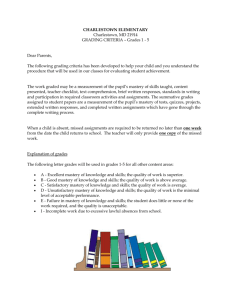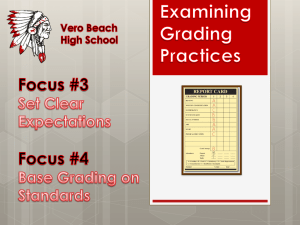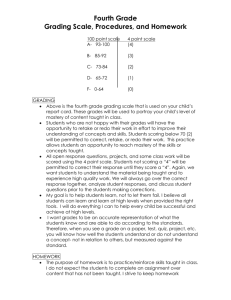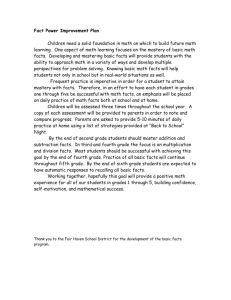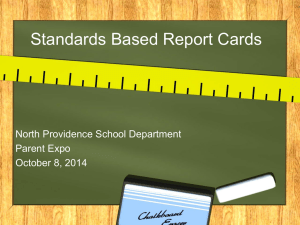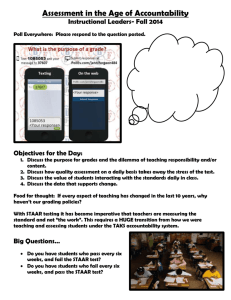Standards-Based Grading - Ms. Mosley-Jensen
advertisement
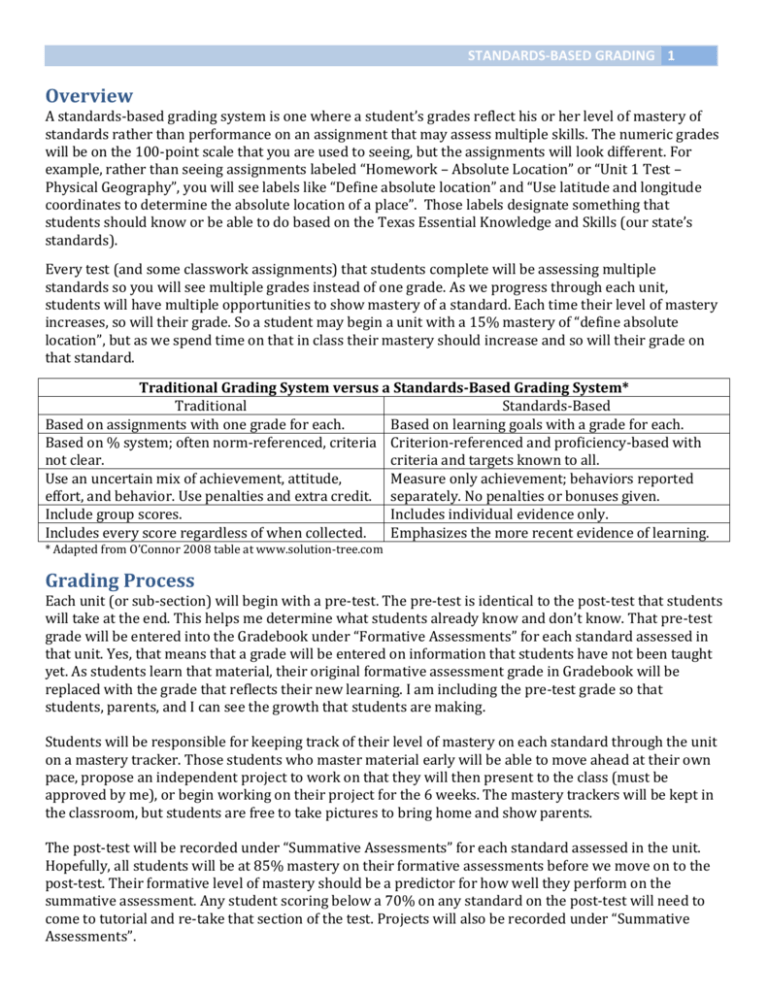
STANDARDS-BASED GRADING 1 Overview A standards-based grading system is one where a student’s grades reflect his or her level of mastery of standards rather than performance on an assignment that may assess multiple skills. The numeric grades will be on the 100-point scale that you are used to seeing, but the assignments will look different. For example, rather than seeing assignments labeled “Homework – Absolute Location” or “Unit 1 Test – Physical Geography”, you will see labels like “Define absolute location” and “Use latitude and longitude coordinates to determine the absolute location of a place”. Those labels designate something that students should know or be able to do based on the Texas Essential Knowledge and Skills (our state’s standards). Every test (and some classwork assignments) that students complete will be assessing multiple standards so you will see multiple grades instead of one grade. As we progress through each unit, students will have multiple opportunities to show mastery of a standard. Each time their level of mastery increases, so will their grade. So a student may begin a unit with a 15% mastery of “define absolute location”, but as we spend time on that in class their mastery should increase and so will their grade on that standard. Traditional Grading System versus a Standards-Based Grading System* Traditional Standards-Based Based on assignments with one grade for each. Based on learning goals with a grade for each. Based on % system; often norm-referenced, criteria Criterion-referenced and proficiency-based with not clear. criteria and targets known to all. Use an uncertain mix of achievement, attitude, Measure only achievement; behaviors reported effort, and behavior. Use penalties and extra credit. separately. No penalties or bonuses given. Include group scores. Includes individual evidence only. Includes every score regardless of when collected. Emphasizes the more recent evidence of learning. * Adapted from O’Connor 2008 table at www.solution-tree.com Grading Process Each unit (or sub-section) will begin with a pre-test. The pre-test is identical to the post-test that students will take at the end. This helps me determine what students already know and don’t know. That pre-test grade will be entered into the Gradebook under “Formative Assessments” for each standard assessed in that unit. Yes, that means that a grade will be entered on information that students have not been taught yet. As students learn that material, their original formative assessment grade in Gradebook will be replaced with the grade that reflects their new learning. I am including the pre-test grade so that students, parents, and I can see the growth that students are making. Students will be responsible for keeping track of their level of mastery on each standard through the unit on a mastery tracker. Those students who master material early will be able to move ahead at their own pace, propose an independent project to work on that they will then present to the class (must be approved by me), or begin working on their project for the 6 weeks. The mastery trackers will be kept in the classroom, but students are free to take pictures to bring home and show parents. The post-test will be recorded under “Summative Assessments” for each standard assessed in the unit. Hopefully, all students will be at 85% mastery on their formative assessments before we move on to the post-test. Their formative level of mastery should be a predictor for how well they perform on the summative assessment. Any student scoring below a 70% on any standard on the post-test will need to come to tutorial and re-take that section of the test. Projects will also be recorded under “Summative Assessments”. 2 STANDARDS-BASED GRADING Things to Know (1) There is a high likelihood that your student will begin each unit with a failing grade. Don’t panic. Those beginning pre-test grades will be replaced with other classwork grades as students complete them. In a traditional grading system all of the grades count towards the overall average, so low grades will adversely affect a student’s average. In this system, a student’s most recent mastery is the ONLY grade that will count towards their average. So if a student scores a 0% on the pre-test on “defining absolute location” and a 100% on a quiz that is two weeks later, the 100 will replace the zero so the student’s grade that will count towards the average is a 100 not a 50. (2) Under this system, students will not have zeros averaged in for missing classwork and homework assignments. Rather, their pre-test grade will be their grade for a standard until they turn in the assignment for that standard. This is both a good and a bad thing. It’s good because it means that there will be no grade penalty for a student not turning in an assignment. In the traditional grading system students’ grades are penalized for not turning in work, although not turning in an assignment is not an indicator that they do not know the material. It is (potentially) a bad thing however because it means that students’ pre-test grades will be the grade that is averaged in for their total grade even if it doesn’t show their level of mastery of the material. This just means that students have to take ownership over the grading process and make sure that their work gets turned in if they want their grade to reflect what they know. I will, of course, give them reminders and follow up with them. They will have zeros averaged in for missing projects and will be assigned a Z.A.P. lab. To complete the project and get it turned in. (3) The progress reports sent home with students will not be an accurate predictor of their final grade for the six weeks. Since the gradebook will still have ONLY pre-test grades for some standards, which will bring the average lower than it will likely be at the end of the six weeks. So that you can see their progress on standards that have been taught so far in the six weeks, which would be a more accurate predictor of their final grade, you can take the average of assignments in the gradebook with the note “Retake”. Class Website: msmosley-jensen.weebly.com
